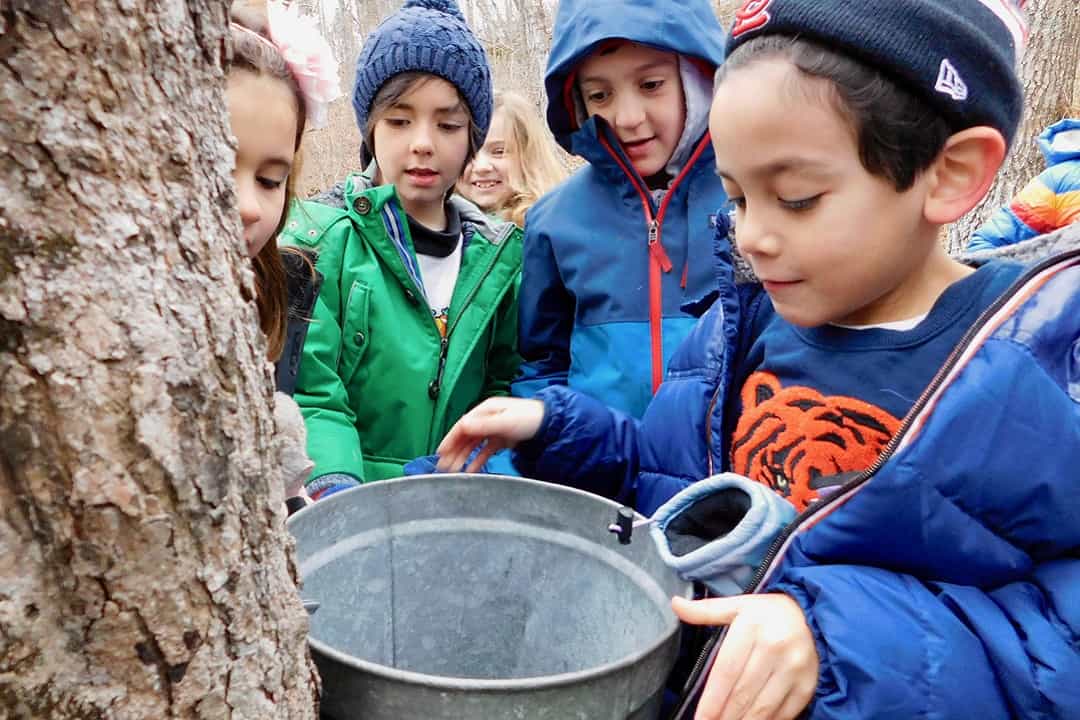On a recent fall morning, a small group of sixth graders sat on a log, waiting their turn to climb a 60-foot tree. The kids were on a three-day camping trip at The College School’s rural property in Pacific, Missouri.
A boy named John easily scaled the tree, supported by a harness and a belay partner (his teacher). John is on a climbing team and said this was no big deal. Next up was a girl who nervously told the teacher that she could only go halfway up.
“OK, show us where that would be,” instructor John Colbert said. She identified a branch and began climbing.
The student soon reached a difficult spot and froze in place, her legs quivering. “I can’t do it,” she said.
“I bet you can!” said another teacher. Kids called out words of support. Colbert told her to trust her right knee and put weight on it. She mustered her courage and made it to her goal, amidst applause from the group.

Climbing out of a ravine at The College School’s property in Pacific, Mo.
Another group of students were learning to rappel down a 25-foot ravine. Cheers rang out every time a student reached the creek bed below.
This scenario may sound pre-pandemic, but kids and staff were wearing face masks and remaining separate from other groups. Experts say getting outside frequently helps reduce transmission of COVID-19, and it comes naturally at The College School.
“The pandemic has been challenging for many schools. For us, it hasn’t been,” said Jill Pampel, admissions director. “We have new protocols in place, but how we teach and learn hasn’t changed.”
Since its founding in 1963, The College School has used the great outdoors as classroom whenever possible. Their main campus in Webster Groves features a garden, greenhouse, and little river.
A Forest School
Raintree School also gets kids outside every day. Located on 11 acres in Town and Country, Raintree is Missouri’s only “forest school”, where play, exploration and risk-taking in a natural setting are supported.
The school accepts children ages 2 through 8, and the property is mostly forest with a creek running through it. Rain or shine, hot or cold, the kids dress for the weather. You won’t find a playground at Raintree, although they do have a climbing structure made of limbs from a felled tree.
“We try not to separate kids from nature,” said Ilya Eydelman, Raintree’s head of school. “We don’t say, ‘Don’t touch that flower’ or ‘Don’t play with the tadpoles.’ We don’t want to wall off nature like a museum exhibit. So, we do let them pick the flowers, because they’ll grow back. Play with the tadpoles — there’s more.”
Kids work on long-term, student-directed group projects each year. Most projects are inspired by the forest, Eydelman says. Starting in pre-K, students are introduced to “design thinking”, which many corporations use to create innovative solutions. Ongoing experimentation occurs until the right solution is found.

Raintree School students building a structure in the woods.
A few years ago, the kindergarteners were concerned about a deer that had lost a leg after being hit by a car. They decided to make a leg for the deer. They found a deer carcass, sanitized it, and reassembled it. They studied the muscular and skeletal system of deer and designed a prosthetic. Then, they invited a physical therapist in (one of the student’s parents).
“She told them you can’t stick a leg on a deer,” Eydelman said. “They were very upset when they realized they wouldn’t be able to do a prosthetic.”
They changed their focus to preventing other deer from being injured or killed. The project lasted well after the kids aged out of Raintree School. They got Town and Country to pass an ordinance authorizing installation of deer deterrent alarms on Mason Road. The kids began raising money for the alarms, but interest has waned as they’ve gone their separate ways.
Other projects include searching for evidence of mammals and measuring the changes brought on by different seasons. Students also grow vegetables that the school chef uses for meals.
“We grow five to 10 percent of our food. The kids are entirely in charge of that,” Eydelman said. “They decide when to plant, what to plant. The point is to understand the labor that goes into it.”
At the College School, each grade level (kindergarten through eighth) ventures out to the Pacific location once or twice a month for adventures of all kinds.
First graders make syrup from sap they’ve collected. They learn about the chemistry behind syrup-making, then celebrate that knowledge with pancakes and waffles.
Third graders build a miniature city in the woods, including businesses, homes, hospitals, and civic buildings. Small solar panels light up the structures.
Journaling about their experiences in nature is part of the process. Reflection helps solidify learning, Pampel said.
“School shouldn’t be drudgery, doing worksheets,” she said. “This is a place we can continue to innovate and expand on themes from the classroom.”
Author: Terri Waters is a regular contributor to Terrain Magazine.


Leave A Comment